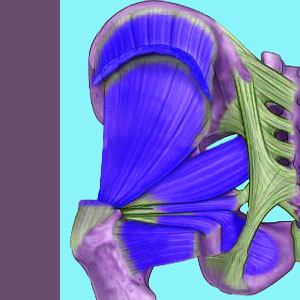
Piriformis pudendal nerve compression is a far less common consequence of piriformis syndrome. Typically, the sciatic nerve is the target of neurological compression by a spasming piriformis muscle, but in some instances the pudendal nerve can suffer entrapment instead of the sciatic or worse still, in addition to the sciatic nerve.
The pudendal nerve is a relatively common site for symptomatic expressions to occur. Pudendal neuropathy is a growing diagnosis for many people with chronic pain in the groin, pelvis, genitals and perineum. It is also one of the less enlightened of the possible diagnoses, since it often does not even venture to ascertain the actual underlying source of nerve pain.
This patient guide provides support for patients who may be suffering from pudendal nerve entrapment caused by the piriformis muscle. We will explore the mechanism by which this compression occurs, the symptoms it may produce and the best path towards successful treatment and symptomatic resolution.
Piriformis Pudendal Nerve Compression Mechanism
The pudendal nerve runs in close proximity to the piriformis muscle and can be entrapped when the muscle goes into spasm. In essence, the piriformis muscle clamps down on the nerve, altering its ability to signal correctly.
There can be other reasons for the pudendal nerve to suffer structural compression, as well as diseases and systemic process that can affect its ability to signal, as well. Ischemia is a common source of direct pudendal nerve symptomology wherein the nerve suffers oxygen deprivation. Ischemia and can also be the underlying source of piriformis spasms, creating pudendal neuropathy both directly and indirectly.
Pudendal Nerve Compression Consequences
Pudendal nerve pain is very difficult to manage, since the symptoms attack some of the most sensitive regions of the anatomy, including the genitals, anus, groin, upper, inner thighs and perineum. Besides pain, many patients will also experience a diversity of neurological expressions, including tingling, numbness and weakness of muscular tissues in these same regions.
Possible consequences of pudendal nerve entrapment include all of the following possible dire expressions:
Urinary or fecal incontinence, constipation, the inability to urinate or intermittent urination might affect patients of either gender.
[contentblock id=1]
Sexual dysfunction can occur, with men suffering the inability to attain or maintain an erection, women having difficulty lubricating or dilating during sex and both genders having trouble orgasming. These consequences might be direct results of a lack of innervation or might be residual secondary effects of pain in the region of intimacy.
Curing Piriformis Pudendal Nerve Compression
Accurate diagnosis of pudendal nerve entrapment is the greatest obstacle to successful treatment. Many patients are misdiagnosed as suffering from a wide range of spinal pain syndromes, such as those often blamed on incidental lumbar herniated or degenerated discs. Some women are misdiagnosed with pelvic floor dysfunction or some type of reproductive organ pain, especially in the presence of incidental cysts or structural abnormities that might be located during diagnostic evaluation.
We find that a significant percentage of piriformis nerve compression is due to regional ischemia, which also directly affects the pudendal nerve itself, escalating symptoms to extreme levels of suffering.
Once an accurate diagnosis can be made, the condition can usually be resolved using the most appropriate form of therapy. For injury or piriformis muscle imbalance, conservative symptomatic care combined with exercises and stretches can usually cure the symptoms. For severe cases, injections of Botox might help relieve the spasms and allow the nerve to enjoy release. In a few particularly severe cases, surgery to free the nerve may be indicated, but these cases are certainly the exception to the rule. We find the most effective form of treatment to be knowledge therapy, due to its lack of risks, high level of efficacy and virtually universal benefits for patients with chronic pudendal nerve symptoms.
Piriformis Pain > Piriformis Diagnosis > Piriformis Pudendal Nerve Compression





